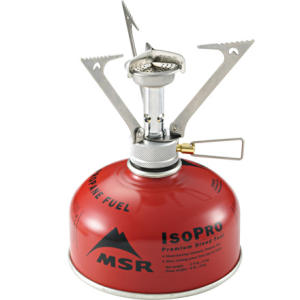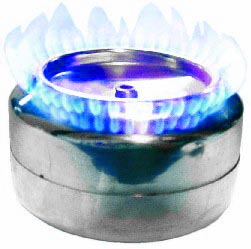Stoves
Fuel Type
The type of fuel a stove burns determines some of the stove's key characteristics. The choices include:
- Liquid Fuel - Usually known as "white gas" or Coleman Camping Fuel, this is bought in one gallon cans and used to refill
either a fuel cannister or the stove's fuel tank. Depending on the stove design, this fuel can work in just about any
temperature. It is about the cheapest type of fuel per hour as one can will last years. In our area, this can be purchased
at Walmart in the camping section.
- Cartridge - The actual type of gas depends on the brand of cartridge. An example is the propane / isobutane mixture in the
MSR cartridges. These are more expensive at around $5 per cartridge that burns 1-2 hours. At very low temperatures, the
cartridge will require preheating. These can be purchased in the same camping stores that sell the stoves or on-line.
- Solid Fuel - Solid fuel pellets can offer significant weight savings, both in the fuel and the stove. Performance is lower
than other stove types. Cost for the Esbit brand can be $6 per 12 tablets. Without an efficient stove (which you would have to
make yourself), each meal will consume 2-3 tablets. These can be purchased in specialty camping stores or on-line.
- Ethanol - Relatively light, in part because the fuel container can be a lightweight pastic bottle, ethanol is mostly used in
home-made stoves. The fuel can be purchased at home improvement centers in the painting solvents section.
Specific Stoves
There are numerous backpacking stoves out there. A few that Troop 54 scouts are likely to encounter.

MSR Pocket Rocket:
The Pocket Rocket runs on non-refillable propane / isobutane cartridges. The troop has three of these that can be checked out by
patrols. Some members of the troop own this stove as well. Key advantages:
- Easy to assemble.
- Light weight - the stove itself is quite small. Total weight for stove, container and full fuel cartridge: 17 oz.
- Easy adjustment
Key disadvantages:
- Requires pre-heating the cartridge in cold weather. Below about 10 °F, the stove needs a hand warmer or similar under the
cartridge to get it going.
- The cartridges are non-refillable, so multiple cartriges will be carried most of the time.

MSR Whisperlite:
The Whisperlite runs on white gas. Some members of the troop own this stove. Key advantages:
- Easy to light and keep lit at any temperature.
- Inexpensive fuel.
- High output - you will be able to boil a few cups of water in a few minutes.
Key disadvantages:
- Somewhat heavy. The stove plus one full fuel bottle is reportedly 28 ounces.
- Not adjustable - Unless you are willing to keep your hand on the fuel adjustmest knob, the stove basically has two positions -
on and off.

Ethanol Stove:
Many home-made ethanol stoves have been fabricated in the troop, with ASM Brian Keevan leading the effort. The ethanol jet stove, made
mostly from pieces of aluminum soda can, is the highest performance of these. Key advantages:
- Very light. The stove is feather light, and small quantities of fuel are required.
- Inexpensive fuel.
Key disadvantages:
- The colder the weather, the harder this will be to light and the lower its output.
- Not adjustable - This stove is either lit or not lit.
- Low output - We have clocked this stove boiling a pint of water in 9 minutes at around 40 °F.
- Prohibited by BSA Policy on the Storage, Handling, and
Use of Chemical Fuels and Equipment (we found out later).
Page updated 3/15/11. |
 |


